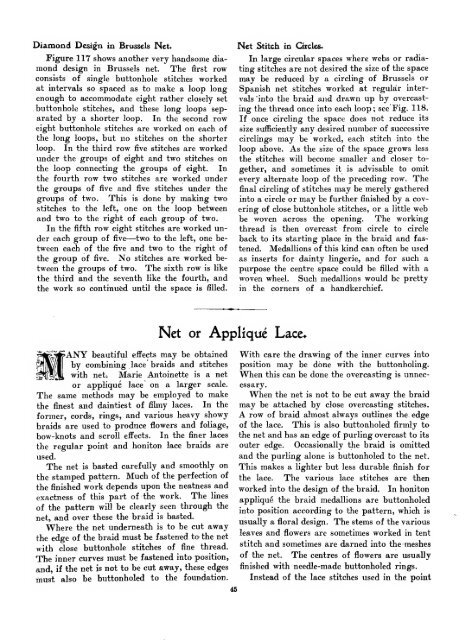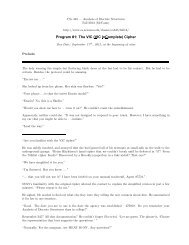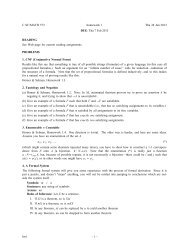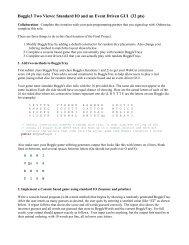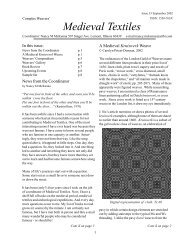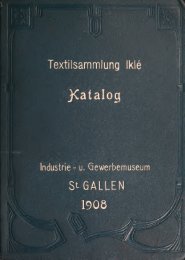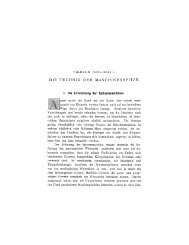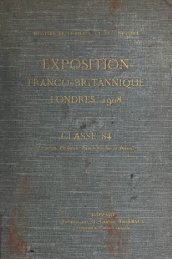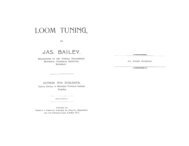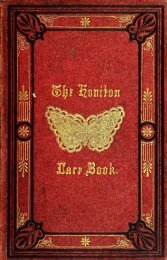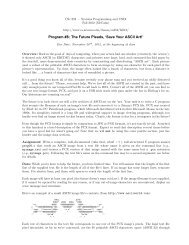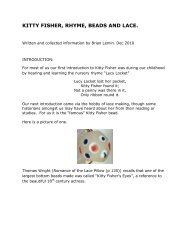The Priscilla Battenberg and point lace book; a collection of lace ...
The Priscilla Battenberg and point lace book; a collection of lace ...
The Priscilla Battenberg and point lace book; a collection of lace ...
Create successful ePaper yourself
Turn your PDF publications into a flip-book with our unique Google optimized e-Paper software.
Diamond Design in Brussels Net.<br />
Figure 117 shows another very h<strong>and</strong>some diamond<br />
design in Brussels net. <strong>The</strong> first row<br />
consists <strong>of</strong> single buttonhole stitches worked<br />
at intervals so spaced as to make a loop long<br />
enough to accommodate eight rather closely set<br />
buttonhole stitches, <strong>and</strong> these long loops separated<br />
by a shorter loop. In the second row<br />
eight buttonhole stitches are worked on each <strong>of</strong><br />
the long loops, but no stitches on the shorter<br />
loop. In the third row five stitches are worked<br />
under the groups <strong>of</strong> eight <strong>and</strong> two stitches on<br />
the loop connecting the groups <strong>of</strong> eight. In<br />
the fourth row two stitches are worked under<br />
the groups <strong>of</strong> five <strong>and</strong> five stitches under the<br />
groups <strong>of</strong> two. This is done by making two<br />
stitches to the left, one on the loop between<br />
<strong>and</strong> two to the right <strong>of</strong> each group <strong>of</strong> two.<br />
In the fifth row eight stitches are worked under<br />
each group <strong>of</strong> five—two to the left, one between<br />
each <strong>of</strong> the five <strong>and</strong> two to the right <strong>of</strong><br />
the group <strong>of</strong> five. No stitches are worked between<br />
the groups <strong>of</strong> two. <strong>The</strong> sixth row is like<br />
the third <strong>and</strong> the seventh like the fourth, <strong>and</strong><br />
the work so continued until the space is filled.<br />
»ANY beautiful effects may be obtained<br />
by combining <strong>lace</strong> braids <strong>and</strong> stitches<br />
with neti Marie Antoinette is a net<br />
or applique <strong>lace</strong> on a larger scale.<br />
<strong>The</strong> same methods may be employed to make<br />
the finest <strong>and</strong> daintiest <strong>of</strong> filmy <strong>lace</strong>s. In the<br />
former, cords, rings, <strong>and</strong> various heavy showy<br />
braids are used to produce flowers <strong>and</strong> foliage,<br />
bow-knots <strong>and</strong> scroll effects. In the finer <strong>lace</strong>s<br />
the regular <strong>point</strong> <strong>and</strong> honiton <strong>lace</strong> braids are<br />
used.<br />
<strong>The</strong> net is basted carefully <strong>and</strong> smoothly on<br />
the stamped pattern. Much <strong>of</strong> the perfection <strong>of</strong><br />
the finished work depends upon the neatness <strong>and</strong><br />
exactness <strong>of</strong> this part <strong>of</strong> the work. <strong>The</strong> lines<br />
<strong>of</strong> the pattern will be clearly seen through the<br />
net, <strong>and</strong> over these the braid is basted.<br />
Where the net underneath is to be cut away<br />
the edge <strong>of</strong> the braid must be fastened to the net<br />
with close buttonhole stitches <strong>of</strong> fine thread.<br />
<strong>The</strong> inner curves must be fastened into position,<br />
<strong>and</strong>, if the net is not to be cut away, these edges<br />
must also be buttonholed to the foundation.<br />
Net Stitch in Cifcles.<br />
Net or Applique Lace*<br />
45<br />
In large circular spaces where webs or radiating<br />
stitches are not desired the size <strong>of</strong> the space<br />
may be reduced by a circling <strong>of</strong> Brussels or<br />
Spanish net stitches worked at regular inter-<br />
vals 'into the braid <strong>and</strong> drawn up by overcast-<br />
ing the thread once into each loop ; see Fig. 118.<br />
If once circling the space does not reduce its<br />
size sufficiently any desired number <strong>of</strong> successive<br />
circlings may be worked, each stitch into the<br />
loop above. As the size <strong>of</strong> the space grows less<br />
the stitches will become smaller <strong>and</strong> closer together,<br />
<strong>and</strong> sometimes it is advisable to omit<br />
every alternate loop <strong>of</strong> the preceding row. <strong>The</strong><br />
final circling <strong>of</strong> stitches may be merely gathered<br />
into a circle or may be further finished by a covering<br />
<strong>of</strong> close buttonhole stitches, or a little web<br />
be woven across the opening. <strong>The</strong> working<br />
thread is then overcast from circle to circle<br />
back to its starting p<strong>lace</strong> in the braid <strong>and</strong> fas-<br />
tened. Medallions <strong>of</strong> this kind can <strong>of</strong>ten be used<br />
as inserts for dainty lingerie, <strong>and</strong> for such a<br />
purpose the centre space could be filled with a<br />
woven wheel. Such medallions would be pretty<br />
in the corners <strong>of</strong> a h<strong>and</strong>kerchief.<br />
With cg,re the drawing <strong>of</strong> the inner curves into<br />
position may be done with the buttonholing.<br />
When this can be done the overcasting is unnec-<br />
essary.<br />
When the net is not to be cut away the braid<br />
may be attached by close overcasting stitches.<br />
A row <strong>of</strong> braid almost always outlines the. edge<br />
<strong>of</strong> the <strong>lace</strong>. This is also buttonholed firmly to<br />
the net <strong>and</strong> has an edge <strong>of</strong> purling overcast to its<br />
outer edge. Occasionally the braid is omitted<br />
<strong>and</strong> the purling alone is buttonholed to the net.<br />
This makes a lighter but less durable finish for<br />
the <strong>lace</strong>. <strong>The</strong> various <strong>lace</strong> stitches are then<br />
worked into the design <strong>of</strong> the braid. In honiton<br />
applique the braid medallions are buttonholed<br />
into position according to the pattern, which is<br />
usually a floral design. <strong>The</strong> stems <strong>of</strong> the various<br />
leaves <strong>and</strong> flowers arc sometimes worked in tent<br />
stitch <strong>and</strong> sometimes are darned into the-meshes<br />
<strong>of</strong> the net. <strong>The</strong> centres <strong>of</strong> flowers are usually<br />
finished with needle-made buttonholed rings.<br />
Instead <strong>of</strong> the <strong>lace</strong> stitches used in the <strong>point</strong>


